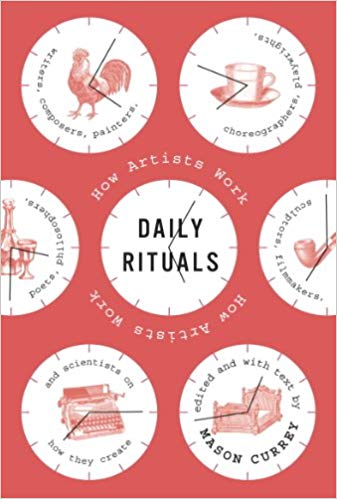Books |
“Daily Rituals: How Artists Work” and “Daily Rituals: Women at Work”
Mason Currey
By
Published: Mar 15, 2022
Category:
Biography
These books are more relevant today than when they were published, and for the simplest of reasons — artists don’t go to offices. Since 2020, that’s been true of many of us. We work from home, and when we’re polled about returning to the office, we fight even the hybrid-model. Is there anything we can learn from the workday habits of artists? Yes, starting with this: start early and don’t stop.
How do female artists — who generally have to juggle roles — get their work done?
And — because voyeurism only goes so far — what can we learn from the work habits of these artists?
Mason Currey was curious to know the answers to these questions. He launched a website, Daily Routines. Many readers showed up. So did agents and editors. Knopf published “Daily Rituals: How Artists Work” in 2013; it’s been translated into 15 languages. [To buy the book, click here. For the Kindle edition, click here.]
When Currey realized that only 27 of the 161 profiles in that book were women, he did something about it — he published a second book, “Daily Rituals: Women at Work.” [To buy the book, click here. For the Kindle edition, click here.]
The short answers are gender-neutral:
1) These artists work hard. They work long hours. Basically, they’re rarely not working.
2) They take walks.
3) They create idiosyncratic work routines that they follow religiously.
4) They drink gallons of coffee and/or take drugs.
5) They suffer. Work lessens their suffering.
Currey’s advice to his readers: “Get up early and go straight to work, making a cup of coffee if you like but not doing much else before sitting down.”
If I’ve just summarized these books, why read them?
Because the stories are fascinating….
Beethoven counted out 60 beans for his morning cup of coffee.
Benjamin Franklin took “air baths” — that is, he sat around naked in the morning, regardless of the weather.
To save Freud time, his wife put toothpaste on his toothbrush each morning.
Jonathan Edwards, an 18th-century theologian, got up early in order to follow Christ’s example: “rising from the grave very early.”
Colette: “A prison is one of the best workshops.”
Balzac drank 50 cups of coffee a day.
Tallulah Bankhead dropped to her knees just before curtain time and prayed: “Dear God, please don’t let me make a fool of myself.” Then she’d drink a glass of champagne.
Tchaikovsky “believed he had to take a walk of exactly two hours a day and that if he returned even a few minutes early, great misfortunes would befall him.”
Louisa May Alcott wrote so much she had to train her left hand to write when her right hand cramped.
Obsession? Here’s Philip Roth:
“I live alone, there’s no one else to be responsible for or to, or to spend time with. My schedule is absolutely my own. Usually, I write all day, but if I want to go back to the studio in the evening, after dinner, I don’t have to sit in the living room because someone else has been alone all day. I don’t have to sit there and be entertaining or amusing. I go back out and I work for two or three more hours. If I wake up at two in the morning–this happens rarely, but it sometimes happens–and something has dawned on me, I turn the light on and I write in the bedroom. I have these little yellow things all over the place. I read till all hours if I want to. If I get up at five and I can’t sleep and I want to work, I go out and I go to work. So I work, I’m on call. I’m like a doctor and it’s an emergency room. And I’m the emergency.”
W.H. Auden is the poster boy for drugs:
Auden rose shortly after 6:00 a.m., made himself coffee, and settled down to work quickly, perhaps after taking a first pass at the crossword. His mind was sharpest from 7:00 until 11:30 a.m., and he rarely failed to take advantage of these hours. (He was dismissive of night owls: “Only the ‘Hitlers of the world’ work at night; no honest artist does.”) Auden usually resumed his work after lunch and continued into the late afternoon. Cocktail hour began at 6:30 sharp, with the poet mixing himself and any guests several strong vodka martinis. Then dinner was served, with copious amounts of wine, followed by more wine and conversation. Auden went to bed early, never later than 11:00 and, as he grew older, closer to 9:30.
To maintain his energy and concentration, the poet relied on amphetamines, taking a dose of Benzedrine each morning the way many people take a daily multivitamin. At night, he used Seconal or another sedative to get to sleep. He continued this routine— “the chemical life,” he called it— for twenty years, until the efficacy of the pills finally wore off. Auden regarded amphetamines as one of the “labor-saving devices” in the “mental kitchen,” alongside alcohol, coffee, and tobacco— although he was well aware that “these mechanisms are very crude, liable to injure the cook, and constantly breaking down.”
More? Currey profiles 304 artists. I open the pages at random, read a profile or two, count that as a break, then get back to writing. At some point, I’ll take a walk. I work long hours. I drink 5 cups of coffee a day. And I’m working at maximum production speed. So I’m a fan of these books — these habits work!


